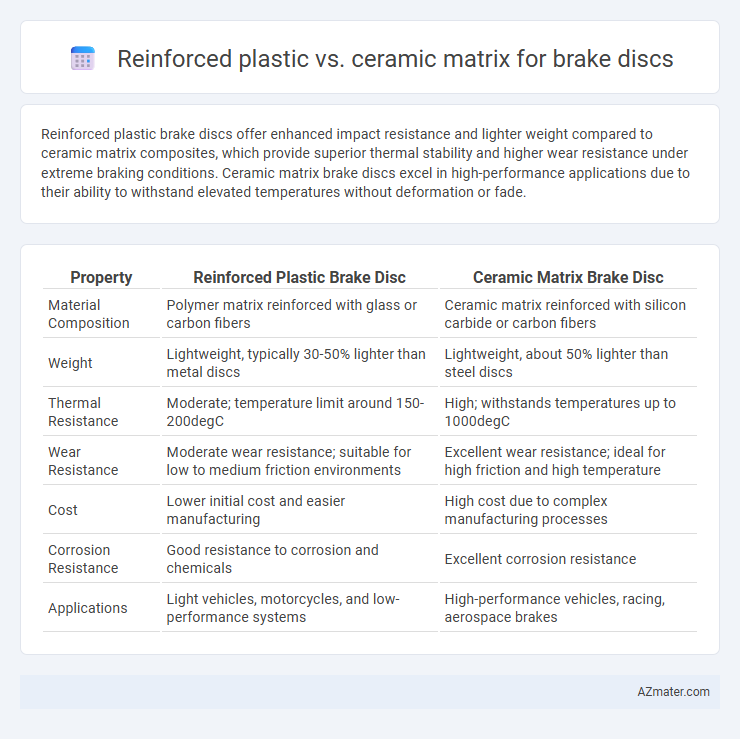Reinforced plastic brake discs offer enhanced impact resistance and lighter weight compared to ceramic matrix composites, which provide superior thermal stability and higher wear resistance under extreme braking conditions. Ceramic matrix brake discs excel in high-performance applications due to their ability to withstand elevated temperatures without deformation or fade.
Table of Comparison
| Property | Reinforced Plastic Brake Disc | Ceramic Matrix Brake Disc |
|---|---|---|
| Material Composition | Polymer matrix reinforced with glass or carbon fibers | Ceramic matrix reinforced with silicon carbide or carbon fibers |
| Weight | Lightweight, typically 30-50% lighter than metal discs | Lightweight, about 50% lighter than steel discs |
| Thermal Resistance | Moderate; temperature limit around 150-200degC | High; withstands temperatures up to 1000degC |
| Wear Resistance | Moderate wear resistance; suitable for low to medium friction environments | Excellent wear resistance; ideal for high friction and high temperature |
| Cost | Lower initial cost and easier manufacturing | High cost due to complex manufacturing processes |
| Corrosion Resistance | Good resistance to corrosion and chemicals | Excellent corrosion resistance |
| Applications | Light vehicles, motorcycles, and low-performance systems | High-performance vehicles, racing, aerospace brakes |
Introduction to Brake Disc Materials
Brake discs commonly utilize reinforced plastics and ceramic matrix composites due to their distinct material properties impacting performance and durability. Reinforced plastics offer lightweight advantages and resistance to corrosion, making them suitable for applications requiring reduced mass and enhanced fuel efficiency. Ceramic matrix composites provide superior thermal stability and wear resistance, enabling consistent braking performance under high-temperature conditions in high-performance and heavy-duty vehicles.
Overview of Reinforced Plastic Brake Discs
Reinforced plastic brake discs combine polymers with fibers such as carbon or glass to achieve lightweight, corrosion-resistant, and thermally stable components ideal for automotive and aerospace applications. These composites offer significant reductions in weight compared to traditional metal or ceramic discs, enhancing fuel efficiency and vehicle handling. However, their thermal conductivity and wear resistance generally fall short of ceramic matrix brake discs, limiting performance in extreme high-temperature environments.
Understanding Ceramic Matrix Brake Discs
Ceramic matrix brake discs offer superior thermal stability and wear resistance compared to reinforced plastic alternatives, making them ideal for high-performance and heavy-duty braking applications. Their ability to withstand extreme temperatures without significant deformation ensures consistent braking performance and longer lifespan under strenuous conditions. Additionally, ceramic composites reduce weight substantially, improving vehicle agility and fuel efficiency while maintaining exceptional stopping power.
Material Properties Comparison
Reinforced plastic brake discs offer lightweight characteristics with high impact resistance and excellent corrosion resistance, making them suitable for applications requiring reduced weight and enhanced durability. Ceramic matrix brake discs provide superior thermal stability, higher wear resistance, and excellent heat dissipation, which significantly improve braking performance under high-temperature conditions. The trade-off between reinforced plastic's flexibility and ceramic matrix's thermal conductivity dictates material selection based on performance requirements and operating environments.
Performance in High-Temperature Conditions
Ceramic matrix brake discs exhibit superior performance in high-temperature conditions due to their exceptional thermal stability, maintaining structural integrity and consistent friction even above 1000degC. Reinforced plastic brake discs, typically limited by lower heat resistance, experience thermal degradation and reduced braking efficiency when exposed to prolonged high temperatures. The thermal conductivity of ceramic matrices also allows rapid heat dissipation, minimizing brake fade and ensuring reliable performance in extreme braking scenarios.
Durability and Wear Resistance
Reinforced plastic brake discs exhibit moderate durability with enhanced wear resistance due to their composite materials, making them suitable for light to medium-duty applications. Ceramic matrix brake discs offer superior durability and exceptional wear resistance, maintaining structural integrity under high thermal stress and prolonged use, ideal for high-performance and heavy-duty braking systems. The ceramic matrix's inherent hardness and thermal stability significantly outperform reinforced plastics in resisting wear and extending service life.
Weight and Efficiency Analysis
Reinforced plastic brake discs significantly reduce overall vehicle weight compared to ceramic matrix composites, offering weight savings of up to 40%, which enhances fuel efficiency and handling. Ceramic matrix brake discs provide superior thermal resistance and wear durability, maintaining consistent braking performance under extreme conditions but at a higher weight penalty. The choice between reinforced plastic and ceramic matrix materials depends on balancing lightweight design priorities with the required thermal efficiency and longevity in braking systems.
Cost Implications and Manufacturing
Reinforced plastic brake discs offer lower production costs due to simpler manufacturing processes and the use of less expensive raw materials compared to ceramic matrix composites (CMCs). Ceramic matrix brake discs, while significantly more costly due to the complex sintering and tooling processes, provide superior thermal resistance and durability that justify higher initial investments in high-performance or heavy-duty applications. The manufacturing scalability of reinforced plastics enables mass production efficiency, whereas CMCs require specialized equipment and longer cycle times, impacting overall cost-effectiveness.
Sustainability and Environmental Impact
Reinforced plastic brake discs offer advantages in weight reduction and recyclability, contributing to lower vehicle emissions and easier end-of-life processing compared to traditional materials. Ceramic matrix composites, while providing superior thermal resistance and durability, involve energy-intensive manufacturing processes with higher environmental footprints. Sustainable brake disc design increasingly favors reinforced plastics due to their lower lifecycle carbon emissions and potential for circular economy integration.
Choosing the Right Material for Brake Discs
Reinforced plastics offer lightweight and corrosion-resistant properties ideal for standard brake discs in passenger vehicles, while ceramic matrix composites provide superior thermal stability and wear resistance suited for high-performance and racing applications. Ceramic matrix brake discs withstand extreme temperatures without significant degradation, enhancing braking efficiency and longevity under aggressive driving conditions. Selecting the right material depends on balancing cost, performance requirements, and operating environment, with reinforced plastics favored for cost-effectiveness and ceramics for high thermal and mechanical stress durability.

Infographic: Reinforced plastic vs Ceramic matrix for Brake disc
 azmater.com
azmater.com